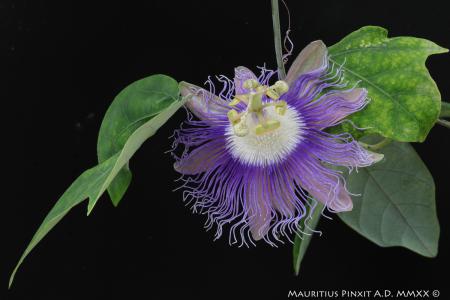
SUBGENUS: passiflora
SUPERSECTION: stipulata
SECTION: granadillastrum
GEOGRAPHICAL DISTRIBUTION OR ORIGIN:
Guyane, French Guiana.
MINIMUM TEMPERATURE: 15 °C
IDEAL MINIMUM TEMPERATURE: 18 °C
SYNONYMS: P. glaucophylla Pulle, P. pruinosa Mast.
ETYMOLOGY: Dedicated to the German botanist Christian August Friedrich Garcke (1819 - 1904) who first described this species.
DESCRIPTION:
P. garckei belongs to the flora of Guyana where almost all the species belonging to the gen. Passiflora have leathery leaves. Here too, in fact, the leaf blade, divided into three lobes separated by open sinuses and furnished with glands, is consistent and shiny with raised ribs. The under surface is blue-green.
Although it is similarly classified as P. amethystina, P. gibertii and others, it has large pale purple flowers that bring to mind the shape of P. incarnata's flowers, thanks also to the imposing corona of filaments. They are therefore very beautiful and often the same branch will bear several open flowers at the same time, creating a very pleasing overall effect.
This passionflower is not very common among collectors and therefore little is known about its adaptability. It is assumed that it requires a minimum temperature of 10°C, too high to acclimatise in open ground. However, it is worth cultivating in pots, as long as tropical or subtropical conditions are assured. In summer, it is possible to keep it outdoors and see it in bloom.
Its flowers reach the remarkable size of 8-9 cm in diameter, and are composed of light purple hooked sepals on the upper surface and petals of the same colour on both sides.
The corona is composed of numerous series of lively filaments, the outermost of which are coloured violet in the centre, fading to very light yellow towards the apex. The innermost ones are white or ivory-coloured.
The fruit has an ellipsoidal shape with a diameter of about 4 cm.
Propagation can be obtained with cuttings or seeds, if fresh seeds are available.
TIMELAPSE: